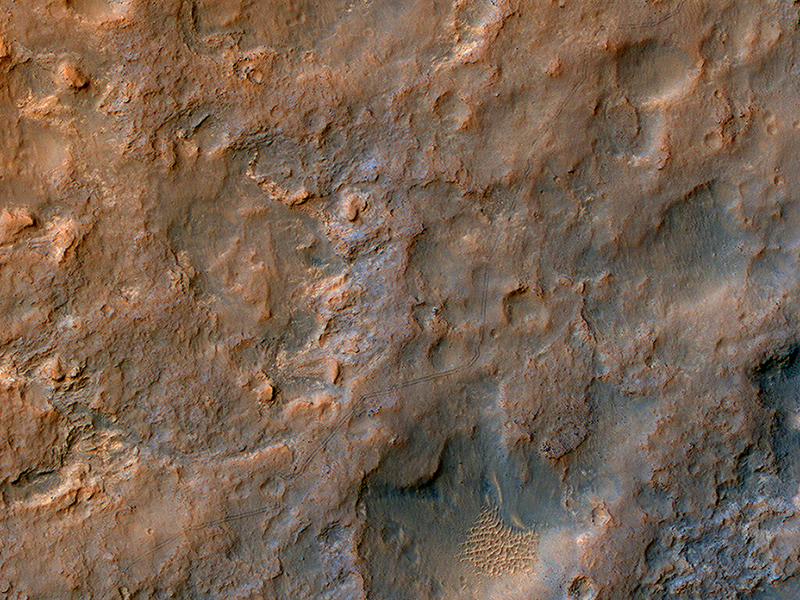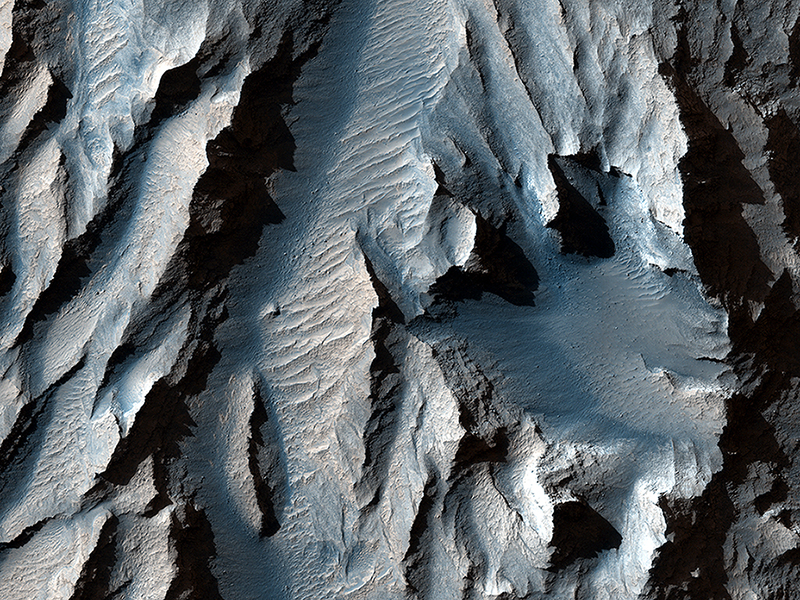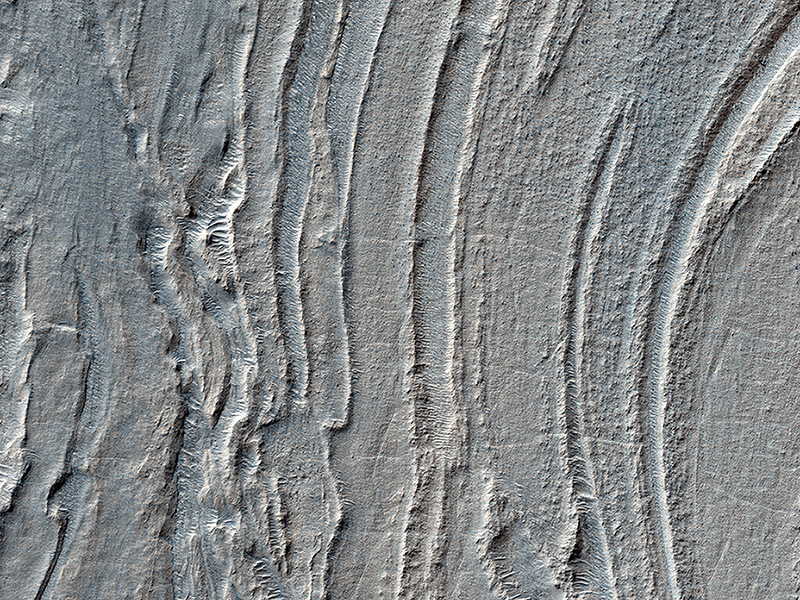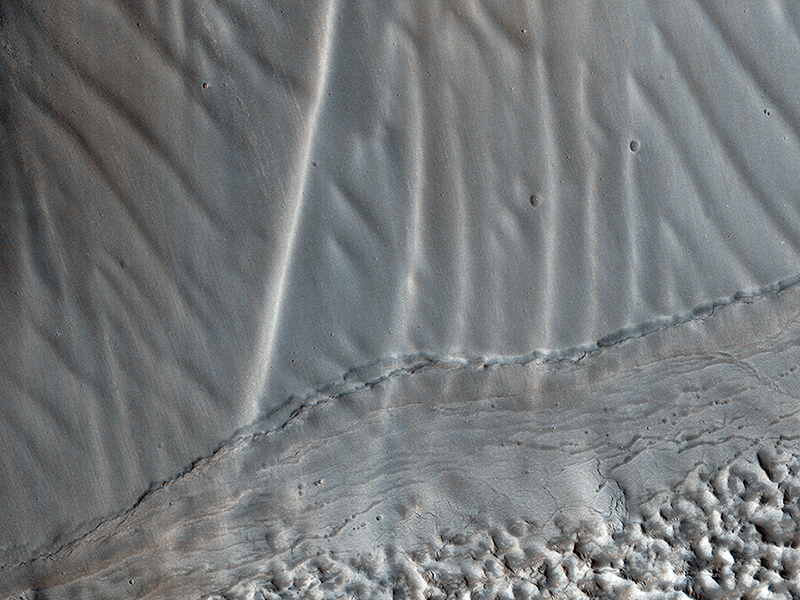Alfred McEwen wrote:Curiosity Trekking (ESP_034572_1755) (HiClip)
Curiosity has been on the move. In this most recent HiRISE image of the MSL rover, the tracks are visible from Yellowknife Bay to its location on 11 December 2013, several kilometers to the southwest. Tracks from its landing site to Yellowknife Bay made more than a year ago are faded but still discernible.
The enhanced color image shows where the tracks cross the narrow (1-kilometer wide) color swath of HiRISE. A black-and-white image subimage shows the rover itself. Rather than follow a straight path to its next destination, the rover has zig-zagged to avoid steep slopes.
Curiosity is progressing from the bright dust-covered area to a region with a darker surface, where saltating sand keeps the surface relatively free of dust. The scenery seen by the rover will be getting more interesting as it progresses toward Mount Sharp.
Edwin Kite wrote:The Obliquity of Mars (Periodic Bedding in Tithonium Chasma) (ESP_034132_1750) (HiClip)
Earth’s seasons are caused by the tilt of our planet’s rotational axis to the orbital plane or obliquity. Mars’ obliquity is currently about 25 degrees, which is not much different from Earth's 23 degrees. However, numerical calculations by scientists at the Paris Observatory and Massachusetts Institute of Technology suggest that this near-agreement is a coincidence.
Under the influence of gravitational torques from other planets, Mars’ obliquity varies chaotically, probably reaching values greater than 60 degrees and lower than 10 degrees. By contrast, Earth’s obliquity appears to have been limited to small variations from its current value because of the stabilizing gravitational influence of the Moon. If the calculations are correct, then for most of the Solar System’s history, the obliquity of Mars was greater than 25 degrees. This would produce warmer summers and colder winters than on present-day Mars. On Earth, a recent 1 degree rise in obliquity is believed to have triggered ice sheet retreat from the current location of New York City to Greenland. The climatic consequences of 50 degree changes in obliquity on Mars remain unknown.
It is possible, though unproven, that higher obliquity triggered partial melting of some of Mars’ water ice. Our best chance at understanding this is to find piles of ice, dust, silt or sand that accumulated over many cycles of obliquity change. Chemical, mineralogical and isotopic variations within those piles could then offer clues to about past climate changes. On Mars, sediment layers of near-uniform thickness visible from orbit are a fingerprint of deposits that record many cycles of obliquity change.
This HiRISE image of an east-facing slope in Tithonium Chasma was taken to follow up an earlier Context Camera image that seemed to show sediment layers of near-uniform thickness. These sediment layers are the dark and light stripes that run diagonally across the center of the observation. In this top-down view, afternoon sunlight picks out subtle east-west trending ridges in the east-facing slope. The dark and light stripes appear to deflect to the east (downslope) across the ridges. To a geologist, this outcrop pattern shows that the dip of the ancient sediment layers is gentler than the slope of the modern hillside. Further analysis of the image may determine whether these layers do record ancient obliquity-driven climate change on Mars.
This is a stereo pair with ESP_034554_1750.
Mike Mellon wrote:Banded Ridges in Hellas (ESP_033995_1410) (HiClip)
Low lying areas in the Hellas region--which is the largest impact basin on Mars--often show complex groups of banded ridges, furrows, and pits. These sorts of bands suggest that the surface material has flowed and twisted viscously like taffy. The orientation of the ridges and groups of ridges would then point in the direction of the flow, called stream lines.
Making this landscape even more complex is when we see that the ridges are sometimes disconnected. They stop abruptly, break up into blocky segments that sometimes appear offset. Such mixed up fragments give an initial sense that parts of the flow have been rafted apart from one another. Alternatively, the entire region may be substantially eroded since the time when the taffy-like ridges actually formed. In that case, the flow may have been far more complex and three dimensional, such that the disconnected portions are actually areas where the flow transitioned up and down relative to the current plane of the eroded surface. In this way we only see a slice through a far more complex series of twists and bends, some of which is still buried beneath the ground.
What this taffy-like material is made of is currently unknown. Hard and soft rocks, as well as ice and ice-rich rocky debris, can deform and flow given time under the force of gravity and the pressures found deep beneath the surface. Afterwards, differential erosion of hard and soft rock or icy materials mixed in bands and layers might give rise to the ridges, furrows and pits which we observe today.
HiRISE Science Team wrote:Rippled Surfaces on a Slope in Coloe Fossae (ESP_033599_2160) (HiClip)
This observation shows us a set of landforms that appears to form a nested “chevron” pattern on a slope in Coloe Fossae. Interestingly, nearby surfaces on the same slope are all parallel.
How do these form? Are they bedforms created by the wind? Why do some slopes have these features and others do not?
Further down the image, we see fretted terrain that’s mostly likely the result of glacial processes. The valley floor offers a stark contrast to the upper slopes and its delicate rippled landforms.
Credit: NASA/JPL/University of Arizona
<< Previous HiRISE Update



